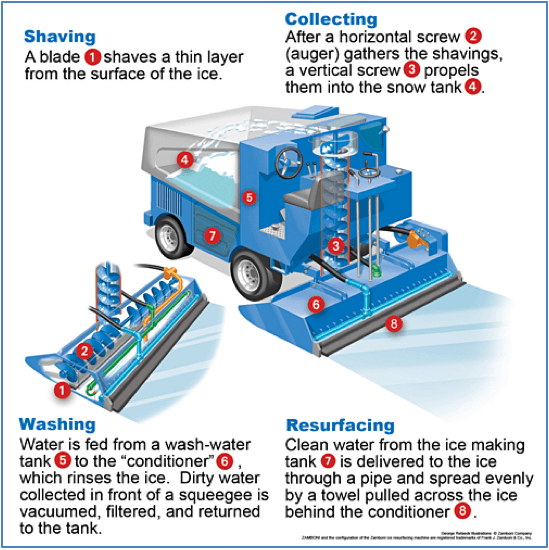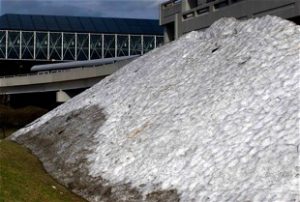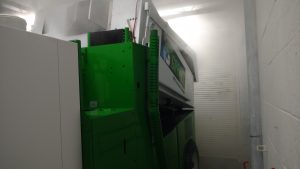THE MECHANICS OF TRADITIONAL ICE RESURFACING

Conventional ice resurfacers employ heavy blades to shave a thin layer from the rink surface. A twin auger system is used to funnel the scraped ice toward a vertical auger, which in turn, lifts the ice shavings up and into a snow dump tank. The scrapings pile up while a water filled reservoir tank sprays the new ice surface to smooth out ruts. As the rink surface refreezes, and before its next use, the ice resurfacer must empty its hefty payload of snow shavings.
The dumping of snow usually involves opening large garage doors to allow access to the facility exterior. Once the ice resurfacer navigates to the dumping area, hydraulic components strain to lift the snow dump tank and its cargo of frozen contaminants.
 The arena snow shavings which sop onto the ground in many cases may contain bio-contaminants… which either seep into the ground or turn into airborne vapour . After dumping the snow, the ice resurfacer returns across the parking lot to prepare for its next flood. The treads of the tires collect sand, salt and other contaminants when driving along the facility’s exterior. Apart from the numerous manners in which contamination may occur from an ice resurfacer exiting the facility, there are other issues involved in the dumping process.
The arena snow shavings which sop onto the ground in many cases may contain bio-contaminants… which either seep into the ground or turn into airborne vapour . After dumping the snow, the ice resurfacer returns across the parking lot to prepare for its next flood. The treads of the tires collect sand, salt and other contaminants when driving along the facility’s exterior. Apart from the numerous manners in which contamination may occur from an ice resurfacer exiting the facility, there are other issues involved in the dumping process.
1 Opening and re-securing the garage door: While open, the industrial sized doors allow the exchange of air between the interior of the facility and the exterior climate. In some conditions, security vulnerabilities might impose the additional costs of surveillance cameras and related personnel.
2 Sweeping and spraying the garage bay: With foot and skate traffic in the facility, it must be ensured that the ice resurfacer does not track in sand or stones from the exterior. This causes unnecessary work for staff and even with careful sweeping or wasteful hose spraying, there may still be salt or sand in the treads of the ice resurfacer. In such conditions, tire checks may also be required.
 3. Refilling the resurfacer’s reservoir tank: According to regulation, large industrial tanks within the facility continually maintain water at high temperatures. The water is fed from the hot water tanks to the ice resurfacer through a hose. This may be time consuming as approximately 700 litres of water is required for each flood. Once outside of the heating tanks, the water begins to cool… optimal temperatures occur when the reservoir tank is filled just prior to use.
3. Refilling the resurfacer’s reservoir tank: According to regulation, large industrial tanks within the facility continually maintain water at high temperatures. The water is fed from the hot water tanks to the ice resurfacer through a hose. This may be time consuming as approximately 700 litres of water is required for each flood. Once outside of the heating tanks, the water begins to cool… optimal temperatures occur when the reservoir tank is filled just prior to use.
What if the water could be heated within the interior of the ice resurfacer? What if the scrapings could be melted and filtered to provide the water required for the flooding process? What if the garage doors did not need to be opened at all? With the GREINS Ice Resurfacing Retrofit System there would be less exposure, less work, less waste and a better ice surface to top it all off.
